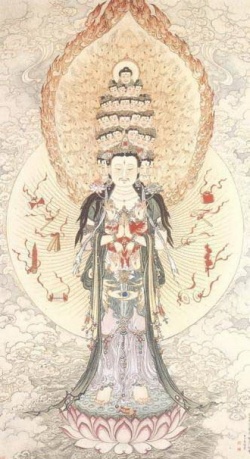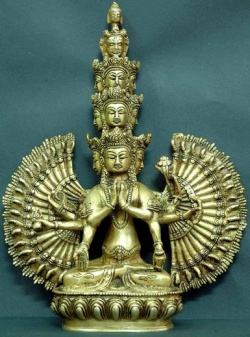Vimalakirti Sutra-
The Vimalakīrti Nirdeśa Sūtra (Sanskrit: विमलकीर्ति निर्देश सूत्र), or Vimalakīrti Sūtra, is a Mahāyāna Buddhist sūtra. The sutra teaches, among other subjects, the meaning of nonduality. It contains a report of a teaching addressed to both arhats and bodhisattvas by the layman Vimalakīrti ("Undefiled Reputation"), who expounds the doctrine of śūnyatā, or emptiness, to them. This culminates with the wordless teaching of silence.
The sutra has been influential in East Asian Buddhism for its "brash humor" and flexibility. It has also been influential in Mahāyāna for its inclusiveness and respect of non-clergy, as well as stating the equal role of Buddhist women, who are considered to have as much spiritual potential as ordained male monks.
Origins
According to Burton Watson, the Vimalakīrti Sūtra probably originated in India in approximately 100 CE. Its central figure is Vimalakīrti, who is presented as the ideal Mahayana lay bodhisattva.
The first translation of the Vimalakīrti Sūtra into Chinese was made in 188 CE, but was lost over time. This translation was made by the Kuṣāṇa monk Lokakṣema, who came to China from the kingdom of Gandhāra. The sūtra was translated six more times at later dates, with the most popular edition being Kumārajīva's translation from 406 CE. Sometimes used in the title, the word nirdeśa means "instruction/advice".
Contents
The sūtra consists of fourteen chapters in Kumārajīva's Chinese translation.
Summary
The opening scene features Śākyamuni Buddha teaching the Dharma to a vast assembly of ordained saṃgha, celestial bodhisattvas, laity, and various devas and other nonhuman beings in the Amra Gardens in the city of Vaiśālī in northeastern India.
In chapter two Vimalakīrti, a wealthy Buddhist lay bodhisattva who is considered a paragon of Buddhist virtue, is feigning illness. When the ruler of the region and various officials and others visit him, he takes the opportunity to expound Dharma teachings.
When Śākyamuni Buddha learns of the situation he asks each of his ten major monk disciples to visit Vimalakīrti during his illness, but each in turn declines to do so, each citing a past incident during which he was reproved by Vimalakīrti for some deficiency in his understanding of the Dharma. The same is repeated with various great celestial bodhisattvas, until Mañjuśrī, the bodhisattva of wisdom, finally agrees.
Vimalakīrti and Mañjuśrī subsequently discuss points of doctrine in Vimalakīrti's room, which miraculously accommodates the multitudes of people who have come to watch. Finally, in the Amra Gardens, Vimalakīrti and Mañjuśrī join Śākyamuni Buddha for further expositions of the Dharma and the performance of demonstrations of their supernatural powers.
The Vimalikirti Sutra "concludes with conventional praises of the sūtra itself and an "entrustment" scene in which Śākyamuni calls on the bodhisattva Maitreya, who is destined to be the next Buddha to appear in this world, to guard the sūtra and ensure that it is widely propagated."
Use of silence
The Vimalakīrti-nirdeśa "offers us two dramatic and contrasting moments of silence. The first of these [is] the silence of Śāriputra", who is rendered silent during an exchange with a goddess:
Śāriputra abandons speech too quickly, after all. He has been asked a question in a particular context [...] to refuse to speak at such a point is neither an indication of wisdom, nor a means of imparting wisdom, but at best a refusal to make progress [...] Śāriputra's failed silence is but a contrastive prelude to Vimalakīrti's far more articulate silence.
Vimalakirti remains silent while discussing the subject of emptiness with an assembly of bodhisattvas. The bodhisattvas give a variety of answers on the question what non-duality is. Manjusri is the last bodhisattva to answer, and says that "by giving an explanation they have already fallen into dualism". Vimalakirti, in his turn, answers with silence.
With this emphasis on silence the Vimalakīrti Nirdeśa Sūtra served as a forerunner of the approach of the Ch'an/Zen tradition, with its avoidance of positive statements on 'ultimate reality':
The Zen tradition is avowedly the Buddhism of Vimalakirti's silence—a claim that is explicitly reinforced by the practice of silent meditation.
But it does not mean that language is to be discredited completely:
Language is not, according to any Mahāyāna school, to be abandoned at the outset; it is not, whatever its limitations, a useless or a wholly misleading cognitive vehicle. To adopt an aphasia or cognitive quietism from the start would be pointless, and, as the Goddess notes, contrary to the practice of the Buddha himself, who uttered an enormous number of words during his career. But of course the episode gets its point precisely from the fact that Buddhist literature is replete with a rhetoric of silence—with episodes of especially significant silence—and indeed, as we discover a mere two chapters later in this very sutra.
Influence in East Asia
John McRae notes that in contrast to India and Tibet where the Vimalakīrti Sūtra left little discernable impact, the sūtra became one of the favorites in East Asian Buddhism. However, he also states that the sūtra was not used as an object of devotion, and that no school was ever formed around it, so that it does not seem to have enjoyed the degree of popularity of some other sūtras.
Richard B. Mather describes the popularity of the Vimalakīrti Sūtra in China as having multiple causes. Among those noted are its "brash" humor, its criticism of śrāvakas and Abhidharma, and the universality and flexibility of its outlook. Mather states that despite its disparagement of śrāvakas, the sūtra is strongly supportive of the Saṃgha, and the text intends to sanction the pursuit of the bodhisattva path by both monastics and laity without opposition to one another.
Hu Shi, an important figure in Chinese language reform in the early 20th century, wrote that the Vimalakīrti Sūtra was among Kumārajīva's three most influential translations (the other two being the Diamond Sūtra and Lotus Sūtra). As a literary work, he praised this version of the sūtra as "half novel and half drama, with the greatest impact on literature and fine arts." Nan Huaijin also regards this translation of the Vimalakīrti Sūtra as unique in Chinese literature, and forming "virtually its own literary realm."
According to Nan Huaijin's description of the Ch'an/Zen monastic system, the abbot of the monastery customarily lived in a small room patterned after that of Vimalakīrti's room. This room, as well as the abbot himself, were colloquially referred to as the fāngzhàng (Ch. 方丈), or "ten-foot square," as Vimalakīrti's room is described in the Vimalakīrti Sūtra.
Texts and translations
Sanskrit editions
In 1981, the Central Institute of Higher Tibetan Studies published a Sanskrit edition of the Vimalakīrti Nirdeśa Sūtra, entitled Āryavimalakīrtinirdeśo Nāma Mahāyānasūtram (आर्यविमलकीर्तिनिर्देशो नाम महायानसूत्रम्).
In 1999, Prof. Hisao Takahashi of Taisho University discovered a Sanskrit original among the Chinese Government's Potala collection in Tibet.
Chinese editions
The Vimalakīrti Nirdeśa Sūtra was translated into Chinese several times, first in approximately 180 CE.
Two especially influential translations are the Kumārajīva version, which is the most widely used, and the Xuanzang version.
There are three ancient Chinese translations extant:
Fóshuō Wéimójié Jīng (佛說維摩詰經) – 2 fascicles, translated by Zhi Qian in 223-228 CE (Taishō Tripiṭaka 474)
Wéimójié Suǒshuō Jīng (維摩詰所說經) – 3 fascicles, translated by Kumārajīva in 406 CE (Taishō Tripiṭaka 475)
Shuō Wúgòuchēng Jīng (說無垢稱經) – 6 fascicles, translated by Xuanzang in 650 CE (Taishō Tripiṭaka 476)
In addition to these, earlier translations had been done by Lokakṣema (188 CE), Dharmarakṣa (308 CE), Upaśūnya (545 CE), and Jñānagupta (591 CE). Of the three extant renditions, Kumārajīva's has traditionally been the most popular.
Japanese editions
Most versions used in Japan are based on the Chinese Kumārajīva version. The Yuimagyō Gisho (維摩経義疏), or Commentary on the Vimalakīrti Sūtra, is an early work of Japanese Buddhism, and is an annotated edition of the text based on the commentary of the Liang Dynasty Chinese monk Zhizang (458-522 CE).
Tibetan editions
There are two translations of the Vimalakīrti Nirdeśa Sūtra from the original Sanskrit into the Tibetan language. Chos-nyid-tshul-khrims translated it into Tibetan in the ninth century.




